|
Battle Of Calebee Creek
The Battle of Calebee Creek (also spelled ''Calabee'', ''Callabee'', or in the official report at the time, "Chalibee") took place on January 27, 1814, during the Creek War, in Macon County, Alabama, west of Fort Mitchell. General Floyd, with 1,200 Georgia volunteers, a company of cavalry and 400 friendly Yuchi, repulsed a night attack of the Red Sticks on his camp. Floyd lost so many in this hostile country that he immediately withdrew to the Chattahoochee River. Also referred to as the Battle for Camp Defiance. Background After the Red Stick attack on Fort Mims (about north of Mobile) in August 1813, the Georgia, Tennessee, and the Mississippi Territory mobilized troops to put down the Red Stick "rebellion." The force consisted of one company of artillery, one squadron of dragoons, a battalion of riflemen and two regiments of infantry. Newly appointed commander of the group, John Floyd made clear his goal to push his column not rapidly, but resistlessly so as to esta ... [...More Info...] [...Related Items...] OR: [Wikipedia] [Google] [Baidu] |
War Of 1812
The War of 1812 (18 June 1812 – 17 February 1815) was fought by the United States of America and its indigenous allies against the United Kingdom and its allies in British North America, with limited participation by Spain in Florida. It began when the United States declared war on 18 June 1812 and, although peace terms were agreed upon in the December 1814 Treaty of Ghent, did not officially end until the peace treaty was ratified by Congress on 17 February 1815. Tensions originated in long-standing differences over territorial expansion in North America and British support for Native American tribes who opposed US colonial settlement in the Northwest Territory. These escalated in 1807 after the Royal Navy began enforcing tighter restrictions on American trade with France and press-ganged men they claimed as British subjects, even those with American citizenship certificates. Opinion in the US was split on how to respond, and although majorities in both the House and ... [...More Info...] [...Related Items...] OR: [Wikipedia] [Google] [Baidu] |
Battle Of Autossee
The Battle of Autossee took place on November 29, 1813, during the Creek War, at the Creek towns of Autossee and Tallasee near present-day Shorter, Alabama. General John Floyd, with 900 to 950 militiamen and 450 allied Creek, attacked and burned down both villages, killing 200 Red Sticks in the process. Background The recent Fort Mims massacre had done nothing but validate Floyd's intentions to prepare for a larger offensive. He had raised a substantial company of militia in Georgia, and had made his way into the Mississippi Territory (in what is today central Alabama) in response to increased tensions between white settlers and Creek factions. As Andrew Jackson, John Coffee and John Cocke made their way south from Tennessee with a force of 3,500 men, Floyd set out along the Federal Road for Autossee, a village of about 1,500 Creek (which included High Head Jim and others responsible for the massacre at Fort Mims). His company included 900 militiamen and 450 allied Creek, ... [...More Info...] [...Related Items...] OR: [Wikipedia] [Google] [Baidu] |
High Head Jim
High may refer to: Science and technology * Height * High (atmospheric), a high-pressure area * High (computability), a quality of a Turing degree, in computability theory * High (tectonics), in geology an area where relative tectonic uplift took or takes place * Substance intoxication, also known by the slang description "being high" * Sugar high, a misconception about the supposed psychological effects of sucrose Music Performers * High (musical group), a 1974–1990 Indian rock group * The High, an English rock band formed in 1989 Albums * ''High'' (The Blue Nile album) or the title song, 2004 * ''High'' (Flotsam and Jetsam album), 1997 * ''High'' (New Model Army album) or the title song, 2007 * ''High'' (Royal Headache album) or the title song, 2015 * ''High'' (EP), by Jarryd James, or the title song, 2016 Songs * "High" (Alison Wonderland song), 2018 * "High" (The Chainsmokers song), 2022 * "High" (The Cure song), 1992 * "High" (David Hallyday song), 1988 * ... [...More Info...] [...Related Items...] OR: [Wikipedia] [Google] [Baidu] |
John H
John is a common English name and surname: * John (given name) * John (surname) John may also refer to: New Testament Works * Gospel of John, a title often shortened to John * First Epistle of John, often shortened to 1 John * Second Epistle of John, often shortened to 2 John * Third Epistle of John, often shortened to 3 John People * John the Baptist (died c. AD 30), regarded as a prophet and the forerunner of Jesus Christ * John the Apostle (lived c. AD 30), one of the twelve apostles of Jesus * John the Evangelist, assigned author of the Fourth Gospel, once identified with the Apostle * John of Patmos, also known as John the Divine or John the Revelator, the author of the Book of Revelation, once identified with the Apostle * John the Presbyter, a figure either identified with or distinguished from the Apostle, the Evangelist and John of Patmos Other people with the given name Religious figures * John, father of Andrew the Apostle and Saint Peter * Pope Jo ... [...More Info...] [...Related Items...] OR: [Wikipedia] [Google] [Baidu] |
Grapeshot
Grapeshot is a type of artillery round invented by a British Officer during the Napoleonic Wars. It was used mainly as an anti infantry round, but had other uses in naval combat. In artillery, a grapeshot is a type of ammunition that consists of a collection of smaller-caliber round shots, which in most cases are about the size of a golf ball, packed tightly in a canvas bag and separated from the gunpowder charge by a metal wadding, rather than being a single solid projectile. Grapeshot also comes packaged in clusters of three by iron rings, and in three tiers, with the shot being held in by cast iron rings. When assembled, the shot resembled a cluster of grapes, hence the name. Grapeshot was used both on land and at sea. On firing, the canvas wrapping disintegrates and the contained balls scatter out from the muzzle, giving a ballistic effect similar to a giant shotgun. Grapeshot was devastatingly effective against massed infantry at short range and was also used at medium rang ... [...More Info...] [...Related Items...] OR: [Wikipedia] [Google] [Baidu] |
Jett Thomas
Jett Thomas (May 13, 1776 – January 6, 1817) was an American military officer, politician, and builder who served as a member of the Georgia House of Representatives and participated in the early construction of the University of Georgia. Early life Jett Thomas was born in Culpeper, Virginia and moved with his family to Oglethorpe County, Georgia in 1784. Career Thomas represented Clarke County, Georgia in the Georgia House of Representatives from 1805 to 1807. He fought in the War of 1812 under Brigadier General John Floyd in the First Brigade of Georgia Militia. Jett led the Baldwin Volunteer Artillery company from Milledgeville, Georgia and was commissioned in November 1816 as a Major General in the Georgia Militia, 3rd Division, for his service in the war. Thomas built the Franklin College of Arts and Sciences, the first permanent building and school at the University of Georgia campus in Athens, Georgia. The college building was designed from the same plans as Co ... [...More Info...] [...Related Items...] OR: [Wikipedia] [Google] [Baidu] |
Battles Of Emuckfaw And Enotachopo Creek
The battles of Emuckfaw and Enotachopo Creek (or Enotachopco Creek) were part of Andrew Jackson's campaign in the Creek War. They took place in January 1814, approximately northeast of Horseshoe Bend. Background After Talladega, Jackson was plagued by supply shortages and discipline problems arising from his men's short-term enlistments. General John Coffee, who had returned to Tennessee for remounts, wrote Jackson that the cavalry had deserted. By the end of 1813, Jackson was down to a single regiment whose enlistments were due to expire in mid-January. Although Governor Willie Blount had ordered a new levy of 2,500 troops, Jackson would not be up to full strength until the end of February. When a draft of 900 raw recruits arrived unexpectedly on January 14, Jackson was down to a cadre of 103 and Coffee, who had been "abandoned by his men." Jackson's men consisted of 175 militia and 30 artillery before the battle and were aided by Lower Creek and Cherokee natives, who had ar ... [...More Info...] [...Related Items...] OR: [Wikipedia] [Google] [Baidu] |
Cherokee
The Cherokee (; chr, ᎠᏂᏴᏫᏯᎢ, translit=Aniyvwiyaʔi or Anigiduwagi, or chr, ᏣᎳᎩ, links=no, translit=Tsalagi) are one of the indigenous peoples of the Southeastern Woodlands of the United States. Prior to the 18th century, they were concentrated in their homelands, in towns along river valleys of what is now southwestern North Carolina, southeastern Tennessee, edges of western South Carolina, northern Georgia, and northeastern Alabama. The Cherokee language is part of the Iroquoian language group. In the 19th century, James Mooney, an early American ethnographer, recorded one oral tradition that told of the tribe having migrated south in ancient times from the Great Lakes region, where other Iroquoian peoples have been based. However, anthropologist Thomas R. Whyte, writing in 2007, dated the split among the peoples as occurring earlier. He believes that the origin of the proto-Iroquoian language was likely the Appalachian region, and the split betw ... [...More Info...] [...Related Items...] OR: [Wikipedia] [Google] [Baidu] |
Lower Creek
The Muscogee, also known as the Mvskoke, Muscogee Creek, and the Muscogee Creek Confederacy ( in the Muscogee language), are a group of related indigenous (Native American) peoples of the Southeastern WoodlandsTranscribed documents Sequoyah Research Center and the American Native Press Archives in the . Their original homelands are in what now comprises southern , much of , western |
Andrew Jackson
Andrew Jackson (March 15, 1767 – June 8, 1845) was an American lawyer, planter, general, and statesman who served as the seventh president of the United States from 1829 to 1837. Before being elected to the presidency, he gained fame as a general in the United States Army and served in both houses of the U.S. Congress. Although often praised as an advocate for ordinary Americans and for his work in preserving the union of states, Jackson has also been criticized for his racial policies, particularly his treatment of Native Americans. Jackson was born in the colonial Carolinas before the American Revolutionary War. He became a frontier lawyer and married Rachel Donelson Robards. He served briefly in the United States House of Representatives and the United States Senate, representing Tennessee. After resigning, he served as a justice on the Tennessee Supreme Court from 1798 until 1804. Jackson purchased a property later known as the Hermitage, becoming a wealthy plan ... [...More Info...] [...Related Items...] OR: [Wikipedia] [Google] [Baidu] |
Federal Road (Creek Lands)
The Federal Road through the territory of the Creek people was a project that started in 1805 when the Creek gave permission for the development of a "horse path" through their nation for more efficient mail delivery between Washington City (modern-day Washington, D.C.) and New Orleans, Louisiana. This section started at Fort Wilkinson near Milledgeville, Georgia, and ended at Fort Stoddert near Mobile, Alabama. By the time of the War of 1812, the Federal Road began in Augusta, Georgia, ran through Fort Hawkins (in Macon, Georgia), on to Fort Mitchell, Alabama (near modern Phenix City, Alabama), and was connected via the Three Notch Road to Pensacola in Spanish West Florida. The Federal Road was at first for mail delivery. It was widened into a war road during 1811, and used during the Creek War (1813–14). The result was removal of most of the Creek people to the West. Another Federal Road (Cherokee lands) went from Savannah, Georgia through northern Georgia to Knoxville, ... [...More Info...] [...Related Items...] OR: [Wikipedia] [Google] [Baidu] |





